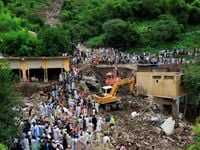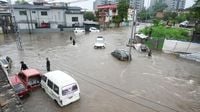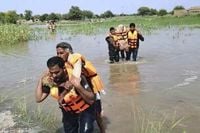Pakistan is reeling from one of its most devastating monsoon seasons in recent memory, as torrential rains, rare cloudbursts, and melting glaciers have unleashed catastrophic flooding across the country. Since August 14, 2025, at least 350 people have lost their lives in the deluge, with the mountainous regions of Buner province and Khyber Pakhtunkhwa bearing the brunt of the destruction. The National Disaster Management Authority (NDMA) has reported that more than 650 people have died since the onset of the monsoon season on June 26, 2025, and the toll is expected to rise as rescue operations continue and more heavy rain is forecast.
The sheer force of nature has left a trail of devastation that is hard to comprehend. Rushing water triggered rockslides that buried houses and buildings, and in the village of Bishnoi, at least half of all homes have been destroyed or rendered uninhabitable, according to reports from local officials. The floods and landslides have swept people away, destroyed infrastructure, and left entire communities cut off from aid. As of August 18, more than 150 people remain missing and at least 180 have been injured, with rescuers working around the clock to search for survivors and deliver relief to the hardest-hit areas.
What makes this disaster particularly harrowing is the speed with which it unfolded. Residents of Buner province, where most fatalities occurred, say they did not receive the usual evacuation alerts or weather warnings on mosque loudspeakers. Local officials have explained that the deluge happened too quickly for any meaningful response. "We’re poor people here, and nine feet of water flooded our homes. People have suffered huge losses – everything, even basic utensils," Mohammad Shabbir, a garment factory owner in Rawalpindi, told Reuters last month. "No one from the government has checked on us or offered help. They didn’t even show sympathy. It’s like we’re invisible."
Others echoed Shabbir’s frustration. Shehbaz Ali, another Rawalpindi resident, told Reuters, "The authorities haven’t lifted a finger. They visit briefly in big vehicles, take note, and leave, while we, the most vulnerable, are left to fend for ourselves." These voices capture the growing sense of abandonment among those who have lost everything, and the mounting pressure on authorities to provide both immediate and long-term support.
The government, for its part, insists it is doing all it can. In a statement, Prime Minister Shehbaz Sharif expressed his condolences and pledged action: "My heartfelt condolences go out to the bereaved families. We stand in solidarity with our brothers and sisters in this hour of grief. The Government is mobilising all resources for rescue and relief operations." Yet, the gap between official assurances and the lived reality of survivors remains stark.
Pakistan’s NDMA has indicated that the majority of deaths have been caused by flash floods, with smaller numbers resulting from house collapses and lightning strikes. The concentration of fatalities in the mountainous northern region is a grim reminder of the particular vulnerability of these communities, where infrastructure is limited and access is often difficult. The situation has been exacerbated by the 2025 monsoon season, which has already brought more than 50% above-average rainfall—a staggering figure that has overwhelmed rivers, dams, and drainage systems.
Rescue and recovery operations have been hampered by ongoing heavy rains, with efforts temporarily halted for several hours on Monday, August 18, due to unsafe conditions. Relief agencies and volunteers are racing against time to find the missing, treat the injured, and deliver food, water, and shelter to those in need. But with roads washed out and entire villages submerged, the challenges are immense.
In the midst of this crisis, the question of how best to help has come to the fore. Disaster experts recommend cash donations to locally led humanitarian organizations, which can direct funds to the areas of greatest need and support both immediate relief and long-term recovery. "Support immediate and long-term needs to help survivors recover now and better withstand future disasters," urges the Center for Disaster Philanthropy, emphasizing the importance of empowering local groups who know their communities best.
Despite the scale of the disaster, the Pakistani government has stated in a news conference that it has sufficient resources for recovery efforts and does not require foreign assistance at this time, according to the Associated Press. This stance stands in contrast to the situation in 2022, when unprecedented floods left a third of the country submerged, about 15,000 dead or injured, and 8 million people displaced—an event the United Nations Development Programme called one of the worst humanitarian crises in Pakistan’s history.
The underlying causes of Pakistan’s vulnerability to such disasters are complex. The World Bank notes that Pakistan faces some of the highest disaster risk levels in the world, in part due to its geography and exposure to both flooding and tropical cyclones. Climate change appears to be making matters worse. A 2022 study by World Weather Attribution concluded that global warming has likely increased the intensity of extreme monsoon rainfall in the region, raising urgent questions about preparedness, adaptation, and resilience.
For many survivors, however, the focus is simply on getting through each day. "Those with means might be able to bear the loss, but we can’t," Shabbir told Reuters. "We’re just struggling to survive." The road to recovery will be long and arduous, requiring not just emergency relief but also sustained investment in rebuilding homes, restoring livelihoods, and strengthening the infrastructure needed to withstand future disasters.
As the rains continue to fall and the true scale of the devastation becomes clear, the people of Pakistan are left to pick up the pieces. The world is watching, but for those on the ground, the struggle is immediate and deeply personal—a fight for dignity, survival, and a chance to rebuild stronger than before.






